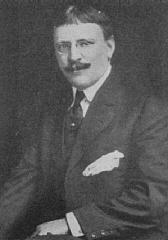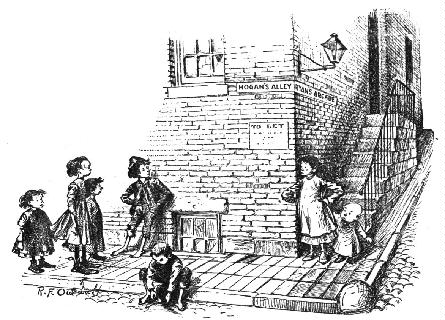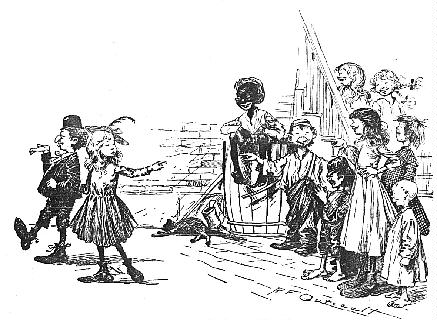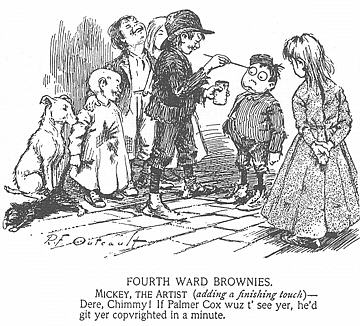R. F.
Outcault,
The Father of the American Sunday Comics, and the Truth About the
Creation
of the Yellow Kid
by
Richard D.
Olson
 Who is the Yellow Kid and why is everybody
making a fuss over him? The answer is that he was the first successful
comic
strip character to achieve a popularity so great that he not only
increased
the sales of newspapers carrying him, but he was also the first to
demonstrate
that a comic strip character could be merchandised profitably. In fact,
for
these two reasons, the Yellow Kid and his creator, R. F. Outcault, are
generally
credited with permanently establishing the comic strip and making it a
part
of American society. Now let's take a closer look at how this
historical
milestone actually occurred.
Who is the Yellow Kid and why is everybody
making a fuss over him? The answer is that he was the first successful
comic
strip character to achieve a popularity so great that he not only
increased
the sales of newspapers carrying him, but he was also the first to
demonstrate
that a comic strip character could be merchandised profitably. In fact,
for
these two reasons, the Yellow Kid and his creator, R. F. Outcault, are
generally
credited with permanently establishing the comic strip and making it a
part
of American society. Now let's take a closer look at how this
historical
milestone actually occurred.
Richard Felton Outcault, known to all who know his work as R. F.
Outcault,
was the comic genius who took advantage of the Zeitgeist. Others had
tried
but failed--Outcault was the first to have the intellect and artistic
ability
to see and depict New York City as many of its residents did, and to be
able
to present it to them in a manner that made them laugh. And for being
in
the right place at the right time, and for possessing unusual innate
and
learned talent, R. F. Outcault became the anointed father of the
American
comic strip.
Outcault was born in Lancaster, Ohio, on 14 January 1863, the son
of Jesse
and Catherine Outcault, and died at his Madison Avenue residence/studio
in
New York City on 25 September 1928. Even as a child it was apparent
that
he had artistic talent, and he developed that talent with training in
the
community. He later entered the McMicken University's School of Design
in
Cincinnati in 1878 and continued his studies for three years. When he
left
in 1881, he took a job as a painter of pastoral scenes for the Hall
Safe
and Lock Company. In 1888, the Centennial Exposition of the Ohio Valley
and
Middle Atlantic States was held in Cincinnati. The Edison Laboratories
electric
light display needed some sophisticated illustrations and hired
Outcault
to do the work. His drawings were superlative, and he soon moved to
Edison's
West Orange, New Jersey, headquarters as a full-time employee. In 1889,
Edison
named him the official artist for his travelling exhibit and sent him
to
Paris for the World's Fair, where he also continued his art studies in
the
Latin Quarter. While in Paris, he developed what was to become a
life-long
preference for berets and capes.
Outcault returned to New York City in 1890 and joined the staff
of Electrical
World magazine, which was owned by one of Edison's friends. He also
freelanced
jokes and cartoons to some of the weekly humor magazines like Truth.
His
humor and art were well received, and his work appeared more and more
frequently,
typically focusing on Blacks living in the imaginary town of
Possumville
or Irish tenement street children living in New York City. Let there be
no
mistake about it, these cartoons were created for adults, not children.
Adults
bought the magazines, not children, and the humor was aimed at adults,
not
children.

2 June 1894, p. 4: Feudal
Pride in Hogan's
Alley
Feudal Pride in Hogan's Alley
Little Rosilla McGraw -- No; we won't come and
play with you, Delia
Costigan. Our rejuced means may temporary necessitate our residin' in a
rear
tenement, but we're jist as exclusive as when we lived on the first
floor
front and papa had charge of the pound in the Department of Canine
Captivity!
Interestingly, virtually no one realizes that the Yellow Kid
first appeared
in Truth magazine four times before his initial appearance in the
newspaper,
and at least once more after that date. It is my pleasure to be able to
list
those four seminal appearances and provide pictures of those cartoons.
- 1. 2 June 1894, p. 4: Feudal Pride in
Hogan's Alley
2. 15 July 1894, p. 14: A Fair Champion
- 3. 15 September 1894, p. 11: Going by
Precept
4. 9 February 1895, p. 10: Fourth Ward Brownies
It must be noted that the last cartoon, "Fourth Ward Brownies," was
reprinted
eight days later in The New York World and thus also became the first
newspaper
appearance of the Yellow Kid. The practice of newspapers reprinting
cartoons
from magazines was not uncommon during that era.

15 July 1894, p. 14
A Fair Champion.
Lorreena Lafferty (as a parting shot)--Remember
dis, Issy Silberman
may be a motzer. But de day will come as a millionaire banker, an' me
his
bride, de dust his carriage wheels makes t'roo Forsythe street will not
be
able den to build youz to his good qualities.
By late 1894, Outcault began submitting work to The New York
World, the
publication with the largest circulation in America. Morrill Goddard,
the
Sunday editor, hired him to do popular scientific drawings. His first
technical
illustration for The New York World was published in September, 1894.
Outcault
also continued to submit work to Truth and other humor magazines
through
the end of the 1890's.

15 September 1894, p. 11
Going By Precept
Mr. Dugan (watching the dinner
preparations)--Sure, that's too much
cabbage for such a little bit of corn bafe! Mrs. Dugan
(authoritatively)--Arrah!
doesn't everybody say that two heads are better than wan?
Exactly when the Yellow Kid first appeared in the newspaper seems
to vary
according to the sources that a given author uses, thus perpetuating
existing
errors. To avoid this problem, I have personally reviewed the microfilm
of
The New York World for 1894 and 1895, and the Yellow Kid's appearances
are
very clear. I am now going to list the first ten appearances of the
Yellow
Kid in the newspaper.
- 1. 17 February 1895
"Fourth Ward Brownies" [reprinted from Truth]
2. 10 March 1895 "The Fate of the
Glutton"
- 3. 5 May 1895 "At the Circus
in Hogan's Alley"
4. 7 July 1895 "The Day after 'The Glorious Fourth' down in
Hogan's Alley"
- 5. 22 September 1895 "The
Great Cup Race on Reilly's Pond"
6. 10 November 1895 "The Great Social Event of the Year in
Shantytown"
- 7. 17 November 1895 "The Horse
Show as Reproduced at Shantytown"
8. 24 November 1895 "An Untimely Death"
- 9. 15 December 1895 "Merry
Xmas Morning in Hogan's Alley"
10. 22 December 1895 "A Hopeless Disappointment"
The first Yellow Kid cartoons were small, only one column by two
inches,
and published in black and white as were the other cartoons of the day.
In
fact, the Yellow Kid was only a secondary character in the early
cartoons.
However, as the strip rapidly gained in popularity, and the Yellow Kid
received
a bright yellow nightshirt, he soon became the central figure in a
full-page
cartoon. All of these developments and many others are characteristic
of
the interaction between the artist of a new comic strip and the public,
and
it took about a year for the strip to reach maturity and for the Yellow
Kid
to become the toast of New York City. The early newspaper cartoons,
like
the magazine cartoons before them, were clearly aimed at the adult
market.

9 February 1895, p. 10
Fourth Ward Brownies
Mickey, The Artist (adding a finishing touch)
-- Dere, Chimmy! If Palmer
Cox wuz t' see yer, he'd git yer copyrighted in a minute.
William Randolph Hearst, the publisher of The New
York Journal, was well
aware of the Yellow Kid fever in the city, and finally lured Outcault
away
from Joseph Pulitzer's World and put him to work at a much higher
salary
drawing the Yellow Kid for the Journal. One of the myths about the
Yellow
Kid is that Pulitzer and Hearst both claimed ownership of the Yellow
Kid,
the case went to court, and the decision resulted in a Yellow Kid comic
in
each newspaper. Most of this myth is true, and there is no question
that
George B. Luks began drawing the Yellow Kid for Pulitzer immediately
upon
Outcault's acceptance of Hearst's offer. Luks continued drawing the
Yellow
Kid in Hogan's Alley and Outcault created a new neighborhood called
McFadden's
Flats. Thus, while the Yellow Kid only appeared in New York City
newspapers,
he did appear in two of them simultaneously! The weak link in the myth
is
the court decision--there doesn't appear to be any record of such a
decision,
and I know a lot of people who have looked for it. Regardless, New York
now
had two Yellow Kids!
Hearst and Pulitzer did everything they could to win the
circulation battle.
In fact, they seem to have published exciting stories about events that
never
occurred, and printed artists' drawings about scenes that didn't exist.
Because
of the furor over the Yellow Kid, the World and the Journal became
widely
known as "The Yellow Kid Papers." This was eventually shortened to "The
Yellow
Papers," which soon became "Yellow Journalism" when emotions increased
even
further over the Spanish-American War. There are dozens of political
cartoons
featuring the Yellow Kid relating to both the publishers and the
expression,
but the best of them was published in VIM by Leon Barritt and is
reproduced
in this article.

The Big Type War of the Yellow Kids
When he finally arrived, however, the public couldn't get enough
of him.
At his peak, he was appearing several times during the week as well as
on
the cover, in a full-page panel, and a half-page sequential comic strip
each
Sunday. The public wanted more and soon the Yellow Kid was being
merchandised
in every imaginable form from soap to whiskey.
Because he was the first successful comic strip character, the
Yellow
Kid was the first comic strip character to inundate the public with his
face!
Today, Yellow Kid collectibles are all rare, highly desirable, and
sought
after by a small but intense cadre of collectors. Please remember that
the
Yellow Kid only appeared in New York City newspapers from 1895 through
1898,
and that the merchandising took place in the same time and place,
making
it very rare today. A variety of items are presented in The R. F.
Outcault
Gallery to illustrate the variety of Yellow Kid collectibles that still
exist
today.
In conclusion, R. F. Outcault and the Yellow Kid demonstrated
that the
Sunday comics could sell newspapers and other forms of merchandise, and
firmly
established the comics as a permanent part of the American newspaper.
The
Yellow Kid, coupled with the artist's subsequent creations, Kelley's
Kids,
Pore Li'l Mose, Buddy Tucker, and Buster Brown, has firmly established
R.
F. Outcault as one of the most important comic artists of all time.
Every
Sunday when I read the comics, I thank him for making it all possible.
Richard D. Olson, Ph.D., 40
Infinity Drive, Poplarville,
MS 39470-9006
(769) 717-4077
redoak2002@gmail.com
[ Home | Appraisals
| Gallery |
History | Newsletters | Society
]
Web Design and Hosting by
Fantastic Transcripts
 Who is the Yellow Kid and why is everybody
making a fuss over him? The answer is that he was the first successful
comic
strip character to achieve a popularity so great that he not only
increased
the sales of newspapers carrying him, but he was also the first to
demonstrate
that a comic strip character could be merchandised profitably. In fact,
for
these two reasons, the Yellow Kid and his creator, R. F. Outcault, are
generally
credited with permanently establishing the comic strip and making it a
part
of American society. Now let's take a closer look at how this
historical
milestone actually occurred.
Who is the Yellow Kid and why is everybody
making a fuss over him? The answer is that he was the first successful
comic
strip character to achieve a popularity so great that he not only
increased
the sales of newspapers carrying him, but he was also the first to
demonstrate
that a comic strip character could be merchandised profitably. In fact,
for
these two reasons, the Yellow Kid and his creator, R. F. Outcault, are
generally
credited with permanently establishing the comic strip and making it a
part
of American society. Now let's take a closer look at how this
historical
milestone actually occurred.




